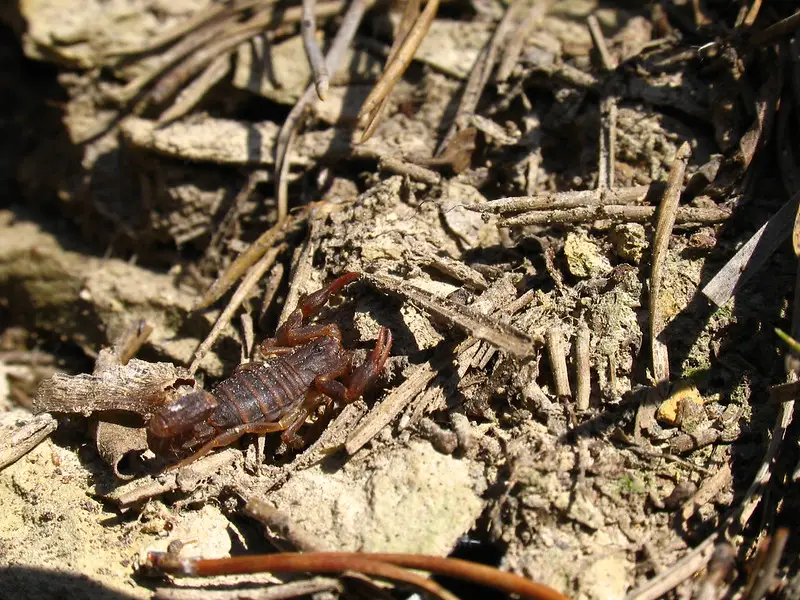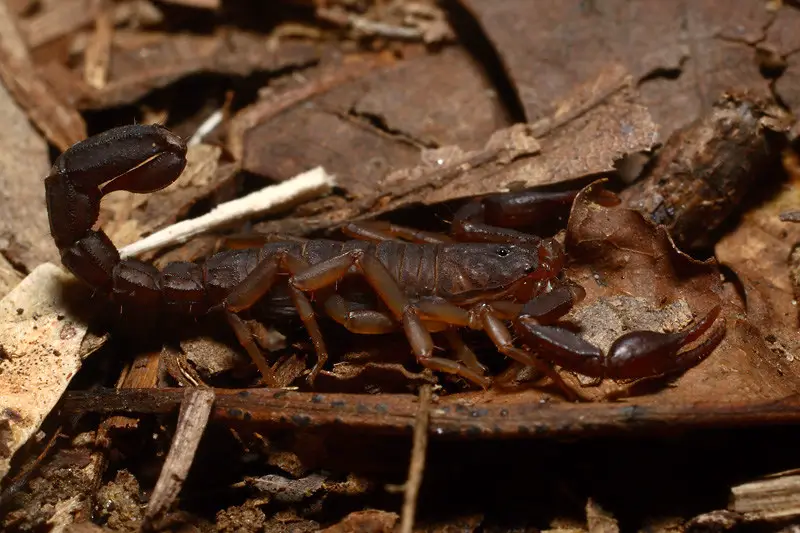The Southern Devil Scorpion, which is also called the southern unstriped scorpion, is the only true scorpion species in the state of Virginia.
A Southern Devil Scorpion sting is of minor medical importance. In fact, the stings from these little guys are no more dangerous than a bee sting.
However, all scorpion stings have the potential to cause severe allergic reactions such as anaphylactic shock. Furthermore, people with pre-existing health conditions, small children, and older adults may be more severely affected by arthropod venoms in general.
If you have severe symptoms such as blurred vision, muscle spasms, or difficulty breathing after experiencing a scorpion sting, seek immediate medical attention.
The state of Virginia is also home to small scorpion-like arachnids called pseudoscorpions. Although they are not true scorpions, their close resemblance makes them mention worthy.
We’ll talk more about both southern devil scorpions and pseudoscorpions in the paragraphs below.
Southern Devil Scorpion (Vaejovis carolinianus)
This scorpion species also has the common names Southern Unstriped Scorpion or Carolina Devil Scorpion.
People associate scorpions with the dry arid country of the western United States. However, there are also types of scorpions that are native to parts of the moist, humid southeastern United States. The southern devil scorpion is one of these.
Where do Southern Devil Scorpions Live?
It is native to all or parts of North Carolina, South Carolina, Florida, Georgia, Louisiana, Virginia, West Virginia, Alabama, Mississippi, Tennessee and Kentucky.
How Dangerous are Southern Devil Scorpions?
According to the book, “The Biology of Scorpions” by Gary A. Polis, there are over 1,500 species of scorpions in the world. Of these, fewer than 25 have stings that are lethal to humans. Southern Devil scorpions are among the non-lethal majority.
These scorpions pack a painful sting. However, the venom of this species is not medically dangerous to normal healthy individuals. People who have been stung by one report that the pain intensity is very similar to a wasp sting.
However, as stated in the opening section, all scorpion stings have the potential to cause severe allergic reactions in some people. Here is the account of James Scully, who was a corporal in the 6th New York Cavalry of the Union Army during the Civil War. While encamped at Fair Oaks, Virginia, in 1862, Corporal Scully suffered a scorpion sting to the back of his neck and nearly died due to the severity of the reaction it produced.
Vaejovis carolinianus or the Southern Devil Scorpion is the only scorpion species native to the state of Virginia. With this in mind, it’s reasonable to assume that this is the scorpion species that produced the severe reaction in Corporal Scully.

What do Southern Devil Scorpions look like?
All scorpions look a little bit like tiny land-dwelling lobsters with some distinctions. Lobsters have 10 legs, while scorpions have 8, and of course, lobsters don’t have a bulbous venom-filled stinger on the end of a narrow tail, while scorpions do.
Southern Devil Scorpion adults are typically 1 to 1 1/2 inches in length. However, larger specimens grow up to three inches long. In color, they are uniformly dark brown to reddish brown.
Southern Devil Scorpion Behavior
Southern Devil Scorpions are nocturnal animals. During the day, they take shelter under rocks, under loose bark, and beneath leaf litter and wood litter on the forest floor.
Around your house, you might encounter these little scorpions in a crawl space, beneath leaf piles or wood piles, in laundry rooms, or even inside one of the garden gloves that you accidentally left outside overnight. If you’re camping in their native areas, be sure to double-check your shoes, your sleeping bag, clothing, and any other possible hiding place that these scorpions might utilize. Luckily, they are very skittish and would rather hide from you than sting you. The only way you’ll ever be stung by one is through accidental contact.
They only use their stinger for defense or to subdue their prey. Their prey, by the way, consists of small insects and arachnids, such as spiders and other scorpions.
How to look for Southern Devil Scorpions
As stated above, during the day, these scorpions hide out. Crawl spaces, wood stacks, the spaces beneath, loose rocks, and leaf litter are all examples of likely hiding spots.
Like all scorpions, Southern Devil scorpions have compounds in their exoskeletons that glow under ultraviolet light. To see them after dark, in your yard, or if you are camping in an area where Southern Devil scorpions are active, the best way to find them is with an ultraviolet flashlight. Use the ultraviolet light to scan your yard or campsite after dark. The scorpions will glow a neon greenish blue.
Remember that the darker the night, the more the scorpion will glow. In other words, they are more luminous on a night of a new moon, for example. What’s more, campfires and other sources of light will cut down on the effectiveness of your UV light source.
One last thing to remember on this subject is that UV light radiating in the 320 to 400 nm range isn’t overly harmful to your vision. However, if you choose to use a UV light source that produces shorter wavelengths, you’ll want to also use eye protection.

Pseudoscorpions in Virginia
Pseudoscorpions also have the common names of book scorpions or false scorpions. These little creatures look a lot like a tiny scorpion minus the stinger. They have a flat, pear-shaped body, eight legs, and a pair of pincers or pedipalps, just like scorpions. However, although they share some similarities with scorpions, they are not actual scorpions.
They are arachnids, though, which means they are related to spiders, scorpions, mites, and ticks. In fact, minus their proportionately large pinchers, false scorpions look a lot like ticks.
People also sometimes mistake these tiny little creatures for ticks. There are over 3,300 pseudoscorpion species worldwide, and their average body length is just 3 millimeters.
Pseudoscorpions live in cracks and crevasses as well as in leaf litter and underneath the bark of dead trees in the outdoors. They will make their way inside people’s homes occasionally. However, they are not a threat to humans.
Book scorpions don’t have a stinger on their tail. However, they do have a stinger in each pincher. They inject their prey with venom to immobilize it. After which, they secrete a fluid over it to dissolve it so that they can ingest the liquified remains.
These tiny arachnids spin silk that they secrete from glands in their jaws. They use this silk to construct cocoons for the purposes of mating, molting, or taking shelter during the winter months.
Book scorpions are generally beneficial to humans since they prey on pests such as clothes moth larvae, carpet beetle larvae, booklice, ants, mites, and small flies. See
You may also like:
Recent Posts
The only venomous snakes in Washington State are Northern Pacific Rattlesnakes. The Northern Pacific Rattlesnake (Crotalus oreganus oreganus) is a sub-species of the Western Rattlesnake. Anyone...
Skunks are not classified as true hibernators. But they go into a state of torpor when the weather gets cold. Skunks are light sleep hibernators, along with opossums, bears, and raccoons. ...

